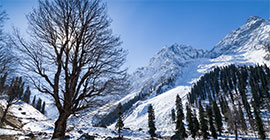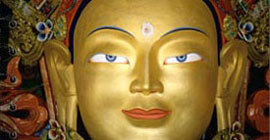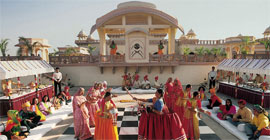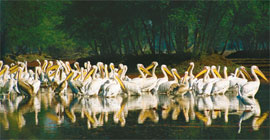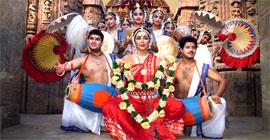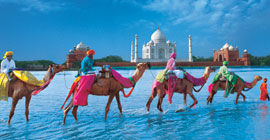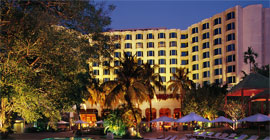bhopal
Home | Bhopal
Jama Masjid
Gold spikes crown the minarets of this beautiful mosque built in 1837 by Kudsia Begum.
Taj-ul-Masjid
The Taj-ul-Masjid is one of the largest mosques in Asia, built by Nawab Shahjehan Begum around a courtyard with a large tank in the centre and with an imposing double storeyed gate-way with 4 recessed archways and 9 imposing cusped multifoiled openings in the main prayer hall. The Quibla wall in the prayer hall is carved with 11 recessed arches, while the mimber is made of black basalt.The structure is enlivened by the limpid expanse of water in the tank outside the northern wall. The monumentality of this structure was much greater originally when it faced the towering bastions of the Fatehgarh Fort. A three-day Ijtima congregation held here annually draws people from all over the country.
Moti Masjid
Architecturally akin to Delhi's Jama Masjid, this imposing mosque was built by Sikander Jehan, daughter of Kudsia Begum, in 1860.
Shaukat Mahal and Sadar Manzil
Situated at the entrance to the Chowk area in the heart of the walled city, Shaukat Mahal is an architectural curiosity. Its mixture of styles in Occidental idioms sets it apart from the predominantly Islamic architecture of the area. It was designed by a Frenchman, said to be a descendent of an offshoot of the Bourbon Kings of France. Post Renaissance and Gothic styles are combined to charming effect here. Nearby is the elegant once-opulent Sadar Manzil, Hall of Public Audience, of the former rulers of Bhopal.
Gohar Mahal
ituated behind Shaukat Mahal on the banks of the Upper Lake is Gohar Mahal, which is an architectural gem dating back to the times of Kudsia Begum, also known as Gohar Begum, who built this sprawling palace in 1820. The Mahal is a magnificent expression of the fusion of Hindu and Mughal architecture.
Bharat Bhawan
One of the most unique national institutes in India, Bharat Bhawan is a centre for the performing and visual arts. Designed by renowned architect, Charles Correa, the contours of Bharat Bhawan merge in exquisite harmony with the landscape creating a visual impact of spacious and natural elegance. The centre houses a museum of the arts, an art gallery, a workshop for fine arts, a repertory theater, indoor and outdoor auditoria, a rehearsal room and libraries of Indian poetry, classical and folk music. Open from 2 pm to 8 pm every day except Mondays.
Indira Gandhi Rashtriya Manav Sangrahalaya (A Post Colonial Museum)
The Indira Gandhi Rashtriya Manav Sangrahalaya (National Museum of Mankind) is a unique Museum, spread over 200 acres of undulating land on the Shamla Hills on the Upper Lake front. It is situated in a prehistoric site and may be the only museum in the world strewn with numerous prehistoric painted rock shelters. It is a post-colonial museum of communities rather than objects, dedicated to in situ revitalisation of local knowledge systems and life enhancing traditions rather than ex situ display of objects. It is engaged in recollection rather than collection. The museum display has been curated directly by the folk and tribal communities, camping at site, to create a miniature presentation of Indian folk ways through display of eco-specific habitations & subsistence practices in the tribal, coastal, desert, and Himalayan habitats. The library, audio-visual archive, computerised documentation and the collection of ethnographic specimens in the Museum, though modest in size are among the best in the world.
Government Archaeological Museum
A fine collection of sculptures are on display here from various parts of Madhya Pradesh. Highlights of the collection are: paintings of various schools, copies of paintings from the Bagh caves near Mandu and the statues of Alakshmi and the Buddha. The museum is closed on Mondays.
Laxmi Narayan Temple and Museum
This beautiful temple on the Arera Hills has a Museum attached to it which houses a collection of sculptures from Raisen, Sehore, Mandsaur and Shahdol districts of Madhya Pradesh. The museum is open from 9am to 5pm every day except Mondays.
Van Vihar
This safari-park is located on a hill adjacent to the Upper Lake, with an area of 445 hectares. In these natural surroundings, wildlife watchers can view a variety of herbivorous and carnivorous species. Open everyday, except Friday, (Timings: 1st April to 30 September, from 7:00 AM to 7:00 PM and 01 October to 31 March, from 7:00 AM to 6:00 PM)
Regional Science Centre
Basically a science museum, located on the picturesque Shamala Hills, Regional Science Centre houses about 300 participatory exhibits distributed equally in 'Invention' & 'Fun Science' galleries, and a 'taramandal' (Planetarium).
The museum remains open from 10.30 am to 6.30 pm on all days except Mondays.
Chowk
In the heart of the city, the Chowk is lined with old mosques, havelis, reminds of a bygone era. The shops in its narrow alleys are treasure troves of traditional Bhopali crafts silver jewellery, exquisitely fashioned beadwork, embroidered and sequined velvet fashioned purses and cushions.
Upper and Lower Lakes
The Upper Lake is divided from the Lower Lake by an overbridge. M. P. Tourism's Boat Club on the Upper Lake provides facilities for exciting trips by sail, paddle and motor boats.
Aquarium
Facing the Lower Lake, the fish-shaped aquarium houses a number of fascinating species of fish in all shapes and sizes.







